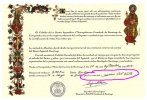pitztop
Solvitur ambulando
- Time of past OR future Camino
- 2022 - Camino de Levante
Recently I met a fellow pilgrim while I was walking the Camino Invierno/Sanabrés earlier this month. He started his Camino in Almería and walked the Camino Mozárabe route before joining the Via de Plata/Sanabrés route into Santiago de Compostela (which is normal). He arrived in SdC a day before I did, and when I arrived we went out for dinner together. He told me that the Pilgrim's Office had issued him a Compostela for the Via de la Plata instead of for the Camino Mozárabe, which disappointed him because he already has a Compostela for the Via de la Plata from a previous Camino. We thought that perhaps there had been a misunderstanding, so he went back to the Pilgrim's Office the next day to see if he could get his Compostela changed to say that he had walked the Camino Mozárabe. Unfortunately, he was unsuccessful. The person he talked to at the Pilgrim's Office told him that the Camino Mozárabe is not an officially recognized route, and the best they could do was issue a Compostela for the Via de la Plata.
I am planning to walk the Camino de Levante next year starting from Valencia. It also joins the Via de la Plata. This leaves me with two questions.
1. Does anyone know if the Camino de Levante is an officially route recognized by the Pilgrim's Office, or do they issue Compostela for the Via de la Plata instead?
2. Does anyone know if there is a definitive list of ALL Camino routes in Spain officially recognized by the Pilgrim's Office in Santiago de Compostela? If so, where can I find it? I have searched and have not been successful.
I know that none of this is very important in the big scheme of things and won't deter me from walking the Camino de Levante next year, but I'm just curious
I am planning to walk the Camino de Levante next year starting from Valencia. It also joins the Via de la Plata. This leaves me with two questions.
1. Does anyone know if the Camino de Levante is an officially route recognized by the Pilgrim's Office, or do they issue Compostela for the Via de la Plata instead?
2. Does anyone know if there is a definitive list of ALL Camino routes in Spain officially recognized by the Pilgrim's Office in Santiago de Compostela? If so, where can I find it? I have searched and have not been successful.
I know that none of this is very important in the big scheme of things and won't deter me from walking the Camino de Levante next year, but I'm just curious










